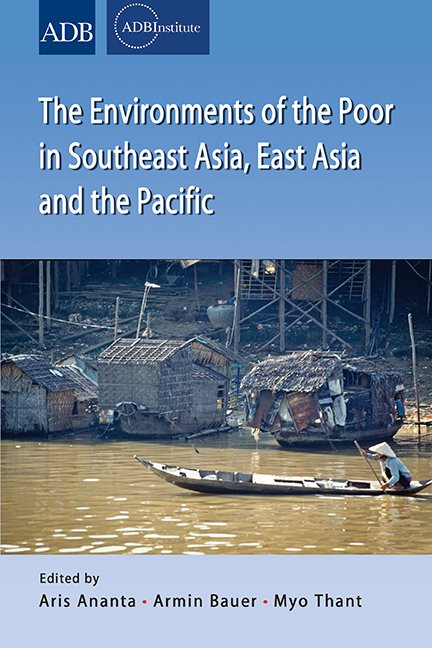Book contents
- Frontmatter
- Contents
- Preface
- List of Contributors
- Part I OVERVIEW
- Part II EAST ASIA (People's Republic of China and Republic of Korea)
- 2 Poverty, Environment, and Climate Change in the Grasslands of China
- 3 Climate Change, Food Security, and Poverty in the People's Republic of China
- 4 The Physical and Social Environment of the Chinese Urban Poor
- 5 Benefiting the Poor, the Environment, and the Private Sector with Small Enterprises and Green Jobs in the People's Republic of China
- 6 Environment, Economic Growth, and Poverty in the Republic of Korea
- Part III PACIFIC ISLANDS
- Part IV MAINLAND SOUTHEAST ASIA (Cambodia, Thailand, Vietnam)
- Part V ARCHIPELAGIC SOUTHEAST ASIA (Indonesia, Malaysia, Philippines)
6 - Environment, Economic Growth, and Poverty in the Republic of Korea
from Part II - EAST ASIA (People's Republic of China and Republic of Korea)
Published online by Cambridge University Press: 21 October 2015
- Frontmatter
- Contents
- Preface
- List of Contributors
- Part I OVERVIEW
- Part II EAST ASIA (People's Republic of China and Republic of Korea)
- 2 Poverty, Environment, and Climate Change in the Grasslands of China
- 3 Climate Change, Food Security, and Poverty in the People's Republic of China
- 4 The Physical and Social Environment of the Chinese Urban Poor
- 5 Benefiting the Poor, the Environment, and the Private Sector with Small Enterprises and Green Jobs in the People's Republic of China
- 6 Environment, Economic Growth, and Poverty in the Republic of Korea
- Part III PACIFIC ISLANDS
- Part IV MAINLAND SOUTHEAST ASIA (Cambodia, Thailand, Vietnam)
- Part V ARCHIPELAGIC SOUTHEAST ASIA (Indonesia, Malaysia, Philippines)
Summary
If environment affects poverty, it is primarily via economic growth. Therefore, it is necessary to investigate how environment affects economic growth. My interest is to find a way to have the environment, economic growth, and poverty reduction interact in a way that results in “pro-poor green growth”. In the first section, I briefly review the relationship between economic growth and poverty. Previous studies and experiences from Korea are introduced. In the second section, I investigate the relationship between the environment and economic growth using empirical findings and a theoretical model. The aim of that section is to find a way that the environment and economic growth can get along. I also deal with the relationship between economic growth and inequality. The poverty rate depends on the nature of economic growth. The third section is about government roles in making growth green and poverty-reducing. It reviews findings from the empirical literature and presents conclusions drawn from the experiences of the Organization for Economic Co-operation and Development. The fourth section concludes the essay.
ECONOMIC GROWTH AND POVERTY
At the Millennium Summit in 2000, world leaders adopted eight goals (the Millennium Development Goals, or MDGs). Reducing poverty and hunger and ensuring environmental sustainability were among them. Policy makers and scholars search for ways to achieve economic growth that is “sustainable” and “pro-poor”. What is pro- poor growth? To answer this question, let us look at Figure 6.1. The figure plots several cases of GDP growth rate and the growth rate of poor people's income. A possible definition of pro-poor growth is a rate of income growth for the poor that is higher than the rate of GDP growth (Kakwani and Pernia 2000). According to this definition, points A and E would be candidates for pro-poor growth. Another definition focuses on the status of the poor (Ravallion and Chen 2003). Specifically, as long as economic growth improves the income of the poor, it could be regarded as pro-poor. By this definition, points A, B, C, and D would be examples of pro-poor growth. It is difficult to decide which definition is superior because both have their pros and cons.
- Type
- Chapter
- Information
- Publisher: ISEAS–Yusof Ishak InstitutePrint publication year: 2013



